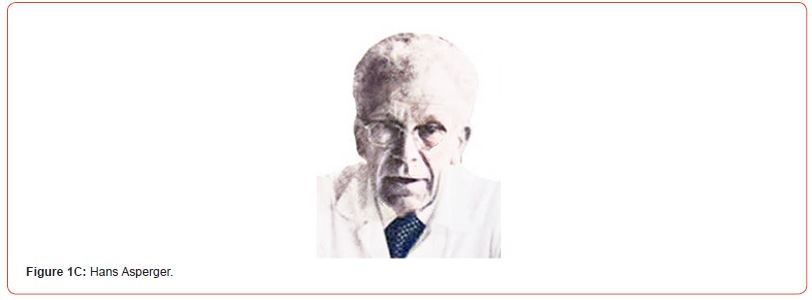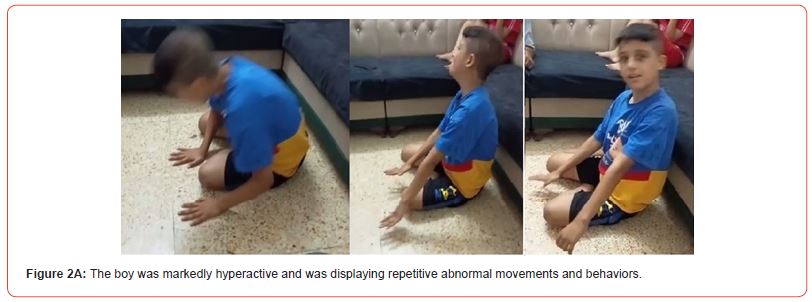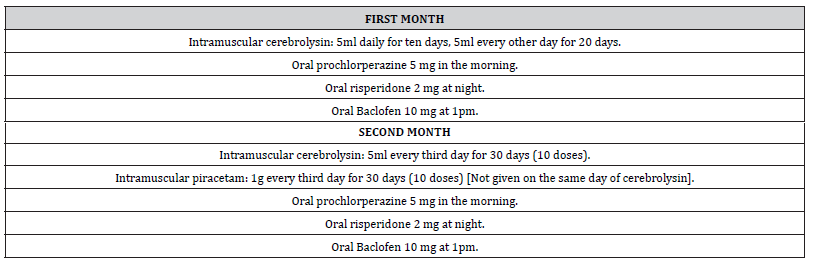 Research Article
Research Article
Autism with Severe Mental Retardation: a Therapeutic Challenge and Expert Opinion
Aamir Jalal Al-Mosawi*
Baghdad Medical City and the National Training and Development Center, Iraqi Ministry of Health, Iraq
Aamir Jalal Al-Mosawi, Advisor and expert trainer, Baghdad Medical City and the National Training and Development Center, Iraqi Ministry of Health, Baghdad, Iraq.
Received Date: April 19, 2023; Published Date: May 08, 2023
Abstract
Background: Autism disorders which are also known pervasive developmental disorders as are very complex and heterogeneous group of chronic disorders that marked by early impairment in socialization, communication, and behavior. Atypical autism associated with severe mental retardation is more likely to be associated with significant hyperactivity and behavioral abnormalities, and thus this association intensifies the therapeutic challenge of autism disorders.
Patients and methods: The challenging case of a ten-year Iraqi boy who has autism disorder associated with severe mental retardation and markedly impaired behaviors is described, and expert opinion is presented.
Results: A ten-year Iraqi boy was seen because of markedly impaired communication, very poor cognitive abilities, no speech development, and severe behavioral abnormalities. He was not responding to name and had no eye contact. He was markedly hyperactive and was displaying repetitive abnormal movements and behaviors. He was not saying any word, not understanding simple commands, and had very poor behaviors and was defecating in place in home and in the street. The boy in this paper was initially treated based on our extensive published experiences with treatment of autism disorders and mental retardation.
Conclusion: Treatment of children with atypical autism associated with severe mental retardation represents a therapeutic challenge and demands the judicious uses of multiple therapies including intramuscular cerebrolysin and piracetam, typical and atypical neuroleptics and baclofen.
Keywords:Atypical autism; Mental retardation; Therapeutic challenge; Expert opinion
Introduction
Autism disorders which are also known pervasive developmental disorders as are very complex and heterogeneous group of chronic disorders that marked by early impairment in socialization, communication, and behavior. Autism disorders were first recognized by Grunya Efimovna Sukhareva (Figure- 1A), a Soviet pediatric psychiatrist in 1925, and she called these disorders autistic psychopathy. The characteristic and diagnostic manifestations of autism disorders result from impairments in social interaction and communication. The impaired social interaction causes the two major diagnostic features of autism which are the lack of eye contact, and the lack of appropriate responsiveness to own name. Difficulties in using and understanding language are an important feature of autism disorders. Repetitive body movements or behavior patterns including hand flapping, foot tapping, and spinning are commonly associated with autism disorders (Figure- 1A).

The Autistic disorder which is called classical autism was first described by Leo Kanner (Figure-1B) in 1943. The diagnostic feature of this type is normal or high intelligence(Figure-1B).
Children with Autism disorder who have subnormal intelligence, but without significant mental retardation are considered to have typical autism. The absence of significant mental retardation in such children is suggested by having acceptable adaptive behaviors including eating with spoon, bowel control and going to bathroom. In children with typical autism disorder, the serious lack of communication skills per se is expected to prevent or delay the acquisition of developmental mile stones. Asperger syndrome was first described by Grunya Efimovna Sukhareva, and later by Hans Asperger (Figure-1C) in 1944.


Atypical autism associated with severe mental retardation is more likely to be associated with significant hyperactivity and behavioral abnormalities, and thus this association intensifies the therapeutic challenge of autism disorders [1-8].
Patients and Methods
The challenging case of a ten-year Iraqi boy who has autism disorder associated with severe mental retardation and markedly impaired behaviors is described, and expert opinion is presented.


A ten-year Iraqi boy was seen because of markedly impaired communication, very poor cognitive abilities, no speech development, and severe behavioral abnormalities. He was not responding to name and had no eye contact. He was markedly hyperactive and was displaying repetitive abnormal movements and behaviors (Figure-2).
He was not saying any word, not understanding simple commands, and had very poor behaviors and was defecating in place in home and in the street. The boy in this paper was initially treated based on our extensive published experiences with treatment of autism disorders and mental retardation [9-16]. Treatment included (Table-1) courses of intramuscular cerebrolysin, low dose typical and atypical neuroleptics including prochlorperazine and risperidone, and baclofen.
Table 1:Initial treatment plan.

Discussion
Atypical autism associated with severe mental retardation is more likely to be associated with significant hyperactivity and behavioral abnormalities, and thus this association intensifies the therapeutic challenge of autism disorders [1-8]. This boy in this paper was initially treated based on our extensive published experiences with treatment of autism disorders and mental retardation [9-16]. Treatment included (Table-1) courses of intramuscular cerebrolysin, low dose typical and atypical neuroleptics including prochlorperazine and risperidone, and baclofen (Table-1).
Cerebrolysin, a safe parenteral mixture of aminoacids which has been used with a benefit in a variety of childhood neuropsychiatric disorders, is the only medical therapy that is known to be associated with significant improvement and even cure of the major autistic features (Poor response to name and poor eye contact which indicate impaired communication) [9-15]. McCracken et al (2002) [16] reported a placebo controlled, double-blind study of the use of risperidone in the treatment of 101 children (82 boys and 19 girls) aged 5 to 17 years, having autism disorder associated with severe tantrums, aggression, or self-injurious behavior. The study found that risperidone was beneficial for the treatment of tantrums, aggression, or self-injurious behavior in children, and was well tolerated [17]. The available research evidence suggests that baclofen, a selective agonist for GABAB receptors can contribute to the impaired function of the GABAergic system in autism disorders and its use with risperidone has been suggested [18]. Parenteral piracetam has been used safely and with a benefit in a variety of childhood neuropsychiatric disorders, and it is one of the most important medications that have been used with benefit in mental and developmental retardation of various types and etiologies [16,19-23].
Conclusion
Treatment of children with atypical autism associated with severe mental retardation represents a therapeutic challenge and demands the judicious uses of multiple therapies including intramuscular cerebrolysin and piracetam, typical and atypical neuroleptics and baclofen.
Acknowledgement
Some of the figures in this paper were included in previous author’s publications, but the author has their copyrights. The author would like to express his gratitude for the parents who willingly accepted publishing the photos of their child.
Conflict of Interest
None.
References
- Al-Mosawi AJ (2018) Asperger syndrome and regressive autism.1st ed., Saarbrücken; LAP Lambert Academic Publishing.
- Al-Mosawi AJ (2018) A new therapeutic approach for pervasive developmental disorders. 1st ed., Saarbrücken; LAP Lambert Academic Publishing.
- Al-Mosawi AJ (2018) Pediatric psychiatry: An accredited training course. 1st ed., Saarbrücken; LAP Lambert Academic Publishing.
- Al-Mosawi AJ (2019) The pattern of pervasive developmental disorders in Iraqi children.1st ed., Saarbrücken; LAP Lambert Academic Publishing.
- Al-Mosawi AJ (2021) Autism disorders in Iraq. Scholars' Press.
- Al-Mosawi AJ (2020) Autism disorders: Cure is possible. 1st ed., Saarbrücken; LAP Lambert Academic Publishing, Saarbrücken; Germany.
- Al-Mosawi AJ (2021) An introduction to child psychiatry: A training course. Scholars’ Press.
- Al-Mosawi AJ (2020) Case Studies in pediatric psychiatry: An approach to deep learning and experience acquisition. SunKrist Journal of Psychiatry and Mental Health 1(1): 1-21[1004].
- Al-Mosawi AJ (2019) The use of cerebrolysin and citicoline in autism and Asperger syndrome. Journal of Bio Innovation (e-ISSN 2277-8330) 8(1): 99-108.
- Al-Mosawi AJ (2019) Pervasive developmental disorders in Iraqi children. Journal of Psychiatry Research Reviews & Reports 1(1): 1-8.
- Al-Mosawi AJ (2020) Clinical uses of Cerebrolysin in Pediatric Neuropsychiatry. Science World Journal of Pharmaceutical Sciences 1(1): 1-4.
- Al-Mosawi AJ (2020) Our experience with childhood pervasive developmental disorders (Autism and Asperger Syndrome): Cure is Possible. EC Clinical and Medical Case Reports 3(4): 01-08.
- Al-Mosawi AJ (2023) Cure of autistic disorders: Mission impossible is possible in an illustrated pioneering experience. Archives of Health Science (ISSN 2641-7456); 4(1):1-26. 4(1):1-26.
- Al-Mosawi AJ (2021) Atypical Autism Associated with Elevated Gonadotrophin and Precious Puberty: A Very Rare Association or a New Clinical Syndrome? Biomedical Journal of Scientific & Technical Research (ISSN: 2574 -1241) 33(2): 256 86-25689.
- Al-Mosawi AJ. A novel therapeutic approach for treating Rett syndrome. EC Clinical and medical case reports 2021 March 01; 4(3): 1-9. Doi: 10.5281/zenodo.45686 52
- Al-Mosawi AJ. The etiology of mental retardation in Iraqi children. SunKrist Journal of Neonatology and Pediatrics.2019 June 21; 1(1):1-9. Article No: sjnp-v1-1001. Doi: 10. 46940/sjnp.01.1001
- McCracken JT, McGough J, Shah B, Cronin P, Hong D, Aman MG, et al. Risperidone in children with autism and serious behavioral problems. N Engl J Med. 2002 Aug 1; 347 (5):314-21. Doi: 10.1056/NEJMoa013171
- Mahdavinasab SM, Saghazadeh A, Motamed-Gorji N, Vaseghi S, Mohammadi MR, et al. (2019) Baclofen as an adjuvant therapy for autism: a randomized, double-blind, placebo-controlled trial. Eur Child Adolesc Psychiatry 28 (12): 1619-1628.
- Al-Mosawi AJ (2020) The use of piracetam and cerebrolysin in the treatment of agenesis of corpus callosum with colpocephaly. EC clinical and medical case reports 3(1): 01-05.
- Al-Mosawi AJ (2020) A Unique experience with mental and developmental retardation: Innovative Medical therapies for idiopathic mental retardation. EC Clinical and Medical Case Reports 3(5): 42-54.
- Al-Mosawi AJ (2020) Recent Uses of Piracetam in Pediatric Neurology. SunKrist Neurology, Neurosurgery and Stroke Journal 2(1): 1002 (1-5).
- Al-Mosawi AJ (2020) The treatment of a child with birth asphyxia induced brain atrophy, adrenal hemorrhage, and bi-lateral hyperoxaluric nephrocalcinosis: A challenging case and a unique experience. Open Access Journal of Biogeneric Science and Research 2(2): 1-6.
- Al-Mosawi AJ (2020) Treatment of a boy with idiopathic mental retardation: From uneducable to educable. SunKrist Clinical and Medical Case Reports Journal 2(1): 1-6.
-
Aamir Jalal Al-Mosawi*. Autism with Severe Mental Retardation: a Therapeutic Challenge and Expert Opinion. Arch Neurol & Neurosci. 15(2): 2023. ANN.MS.ID.000858.
-
Decompression Surgery, Neurosurgery, Anesthesiology, Medical Science, Bupivacaine, Pain relief, Lumbar decompression surgery, Neural complications, Nerve tissue.
-

This work is licensed under a Creative Commons Attribution-NonCommercial 4.0 International License.






